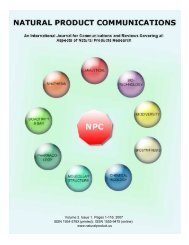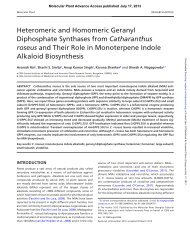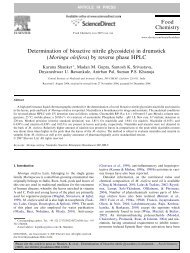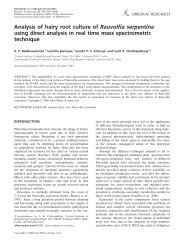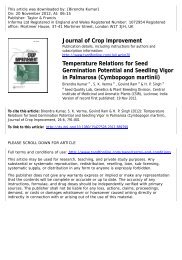Rose-scented geranium - CIMAP Staff - Central Institute of Medicinal ...
Rose-scented geranium - CIMAP Staff - Central Institute of Medicinal ...
Rose-scented geranium - CIMAP Staff - Central Institute of Medicinal ...
You also want an ePaper? Increase the reach of your titles
YUMPU automatically turns print PDFs into web optimized ePapers that Google loves.
Plant Cell Tiss Organ Cult (2007) 90:215–223 221Table 4 Oil content and percent concentration (±SD) <strong>of</strong> the terpenoid constituents in essential oils <strong>of</strong> transgenic plants and the wild type Pelargonium graveolens cv. HemantiCompound Control A-6 2TG 5TG 6TG 10TG 12TG I3TG 15TG 2OTG LZ-3 14TGOil content (%) 0.15 ± 0.01 0.11 ± 0.01 0.10 ± 0.06 0.06 ± 0.001 0.10 ± 0.01 0.09 ± 0.005 0.11 ± 0.005 0.05 ± 0.001 0.10 ± 0.04 0.10 ± 0.017 0.11 ± 0.010 0.11 ± 0.010Linalool 0.50 ± 0.04 1.00 ± 0.02 0.50 ± 0.02 0.30 ± 0.004 0.60 ± 0.008 0.50 ± 0.01 0.60 ± 0.016 0.40 ± 0.020 0.30 ± 0.005 0.90 ± 0.01 1.60 ± 0.04 0.90 ± 0.010<strong>Rose</strong> oxides (cis + trans) 2.50 ± 0.09 2.60 ± 0.14 1.60 ± 0.06 1.90 ± 0.07 0.70 ± 0.015 1.60 ± 0.09 1.80 ± 0.07 2.60 ± 0.16 2.40 ± 0.07 2.30 ± 0.02 1.60 ± 0.04 trIsomenthone 9.60 ± 0.40 10.9 ± 0.13 8.20 ± 0.11 9.50 ± 0.68 4.0 ± 0.28 8.00 ± 0.31 9.30 ± 0.37 9.40 ± 0.51 10.3 ± 0.49 9.50 ± 0.36 7.90 ± 0.33 1.80 ± 0.12Citronellol 47.0 ± 0.65 46.1 ± 0.45 45.6 ± 0.27 47.0 ± 0.62 54.4 ± 0.69 48.3 ± 0.78 52.4 ± 0.32 46.3 ± 0.66 46.9 ± 0.74 52.7 ± 0.55 35.7 ± 0.30 33.3 ± 0.88Geraniol 1.10 ± 0.11 0.70 ± 0.004 1.20 ± 0.06 0.50 ± 0.08 1.90 ± 0.09 0.80 ± 0.14 1.40 ± 0.06 0.40 ± 0.12 0.50 ± 0.08 2.00 ± 0.10 9.60 ± 0.40 7.90 ± 0.746- Caryophyllene 2.00 ± 0.09 2.10 ± 0.09 2.30 ± 0.12 2.50 ± 0.21 2.20 ± 0.05 2.10 ± 0.06 1.70 ± 0.03 2.30 ± 0.16 2.40 ± 0.10 1.60 ± 0.08 1.30 ± 0.06 2.00 ± 0.05Guaia-6,9- diene 2.70 ± 0.12 2.20 ± 0.09 1.40 ± 0.11 1.80 ± 0.06 1.40 ± 0.07 2.50 ± 0.10 2.00 ± 0.01 2.30 ± 0.08 1.80 ± 0.06 1.70 ± 0.54 0.30 ± 0.02 0.30 ± 0.01610-epi-Y-Eudesmol 3.80 ± 0.15 0.20 ± 0.01 4.40 ± 0.14 3.00 ± 0.21 5.00 ± 0.07 4.20 ± 0.05 4.20 ± 0.09 4.20 ± 0.08 3.00 ± 0.12 3.00 ± 0.14 6.60 ± 0.15 10.3 ± 0.27Citronellyl esters 20.4 ± 0.43 23.8 ± 0.49 23.2 ± 0.81 22.8 ± 0.72 19.7 ± 0.41 19.6 ± 0.96 17.0 ± 0.69 21.6 ± 0.62 22.7 ± 0.78 17.5 ± 1.16 12.9 ± 0.65 14.9 ± 0.88Geranyl esters 2.20 ± 0.09 1.50 ± 0.06 1.90 ± 0.04 1.50 ± 0.03 2.60 ± 0.09 1.80 ± 0.12 2.30 ± 0.12 1.10 ± 0.05 1.80 ± 0.03 2.00 ± 0.16 9.00 ± 0.19 14.8 ± 0.73tr, traceFig. 3 PCR pr<strong>of</strong>iles <strong>of</strong> DNA isolated from 11 transgenic plantsand their parent Pelargonium graveolens cv. Hemanti amplifiedwith primer OPT1 5 0 GGGCCACTCA3 0 and resolved on0.8% agarose gel. Samples in gel lanes (from right to left) areas follows: Lane 1: marker k DNA digested with HindIII ; Lane2: wild type Pelargonium graveolens cv. Hemanti; Lanes 3,4and 5: 2TG (in replicates); Lane 6: 5TG; Lane 7: 6TG; Lane 8:LZ-3; Lanes 9 and 12: 14TG (in replicate); Lane 10: 10TG;Lane 11: 12TG; Lane 12: 14TG; Lane 13: 13TG; Lane 14:15TG; Lane 15: 20TG; Lane 16: A-6pr<strong>of</strong>iles from that <strong>of</strong> the control oil (Table 4). Thesetwo oils had comparatively lower concentration <strong>of</strong>citronellol (33.3% and 35.7%) and higher concentration<strong>of</strong> geraniol (6.6% and 10.3%) than the control oilwhere citronellol was 47% and geraniol was 2.1%.Since the citronellol:geraniol ratio in <strong>geranium</strong> oilsdetermines their odour value (Lawrence 1984) thesetwo oils represent better quality oils resemblingBipuli type (Rao et al. 1999). The oils <strong>of</strong> these twotransgenic plants also possess relatively higheramounts <strong>of</strong> linalool, geranyl esters and 10-epi-ceudesmolas compared to that <strong>of</strong> the control. On theother hand, the concentrations <strong>of</strong> 6, 9-guaiadiene andthe esters <strong>of</strong> citronellol were found to be low in thesetwo oils as compared to the oil <strong>of</strong> the control. Further,the concentrations <strong>of</strong> isomenthone and rose oxideswere quite low (1.8% and trace, respectively) in one<strong>of</strong> these two oils (14TG) as compared to the oil <strong>of</strong>control (9.6% and 2.5%, respectively). At the geneticlevel these two transgenics resembled each other withregard to OPT 1 primer while distinct differencescould be noted between them from the others alongwith the wild type control with regards to sameprimer (Fig. 3) which further substantiates theirtotally altered oil pr<strong>of</strong>ile in terms <strong>of</strong> the majorterpenoid constituents. On the basis <strong>of</strong> overallanalysis, it can be stated that since the increase ingeraniol and geranyl esters concentration signifiesimproved olfactory value (Rao et al. 1999), the oils <strong>of</strong>these two transgenics definitely represent an improvementover the control from the commercial point <strong>of</strong>123




